Wonderland Burlesque's Let's All Go To The Movies:
Broadway Melody Edition
Yes, show biz folk, in all their glory; the grit, the glam, the flim, the flam... they wouldn't have it any other way.
It's all for that big opening night and the sound of applause.
So, raise the curtain, light the lights... it's time for a sweet Broadway Melody!
--- ---
The Broadway Melody
(1929)
AKA: The Broadway Melody of 1929
This American pre-Code musical was the first sound film to win an Academy Award for Best Picture. It was also one of the earliest musicals to feature a Technicolor sequence, which sparked the trend of color being used in a flurry of similar musicals which would hit the screens from 1929 through 1930. Today, the Technicolor sequence survives only in black and white. The film was the first musical released by Metro-Goldwyn-Mayer and was Hollywood's first all-talking musical.
Written by Norman Houston and James Gleason from a story by Edmund Goulding, this film was directed by Harry Beaumont and stars Bessie Love, Charles King and Anita Page. It features original songs written by Arthur Freed and Nacio Herb Brown, including the popular hit You Were Meant for Me. Bessie Love was nominated for an Academy Award for Best Actress for her performance.
Because this movie was one of the early sound features made, the production team learned how to record sound properly by trial-and-error. After the rushes were seen, the sets were changed to improve recording quality and scenes were re-shot, resulting in long days for the actors and an overall long shooting schedule. For example, it took over three hours to film Bessie Love's brief ukulele-playing scene. For earlier takes, a full orchestra was off-camera, but for later takes, the actors sang and danced to prerecorded music. A silent version of the film was also produced, as there were still many motion picture theaters without sound equipment at the time.
The film featured a musical sequence for The Wedding of the Painted Doll which was presented in early two-color Technicolor (red and green filters). Color quickly became associated with the musical genre, and numerous features were released in 1929 and 1930 that either featured color sequences or were filmed entirely in color. Movies like On with the Show (1929), Gold Diggers of Broadway (1929), Sally (1929), The Life of the Party (1930), among others, all featured color footage.
This film was a huge success and made a profit of $1.6 million for MGM. It was the top grossing picture of 1929 and won the Academy Award for Best Picture at the 2nd Academy Awards. In addition, Harry Beaumont received a nomination for Best Director, and Bessie Love was nominated for Best Actress.
--- ---
(1935)
This musical was released by Metro-Goldwyn-Mayer in 1935, as a follow-up of sorts to the successful The Broadway Melody (1929), although, there is no story connection with the earlier film beyond the title and some music.
Originally scheduled to be completed in four weeks, the picture ended up taking four months to complete.
Eleanor Powell was spotted in a Fox screen test by MGM studio chief Louis B. Mayer, who, due to the grainy quality of the test, initially thought she was African-American. Once Fox cast her in George White's Scandals (1934), MGM made its move. Reportedly, Powell did not want to participate in this film, as she was slated for the non-dancing role eventually played by Una Merkel. Too much of a neophyte to confront the studio executives, she engineered her dismissal by politely demanding the lead role and an exorbitant salary. Imagine her surprise when the studio met her terms, paving the way for her meteoric film career. Her singing was dubbed by Marjorie Lane, as it would be for the remainder of Powell's movie career.

The success of Powell's dance routines relied heavily upon production values, as Powell choreographed her own numbers, all of which were nearly identical. It was the costuming and lavish set creations which provided variety and prevented audiences and critics from taking note of the fact that they were highly repetitive.
This was the film debut of Buddy Ebsen. Buddy and Vilma Ebsen had appeared together as a brother-and-sister act in vaudeville. This film marked their film debut. However, Vilma retired soon after to marry musical director Robert Emmett Dolan, leaving Buddy to stay on at MGM, and eventually make his mark in television as the iconic star of two long-running series, The Beverly Hillbillies and Barnaby Jones.
The film was nominated for three Oscars at the 8th Academy Awards: Best Picture, Best Writing (Original Story), and Best Dance Direction, winning the last one.
Broadway Melody of 1938
(1937)
--- ---
Broadway Melody of 1940
Johnny Brett and King Shaw are a dance team so down on their luck that they work in a dance hall for no money. Meanwhile, Clare Bennett is a big Broadway star. Owing to a case of mistaken identity, Shaw is offered the chance to be Clare's dancing partner in a new Broadway show, when Johnny's dancing was really what producer Bob Casey saw and wanted. The partnership breaks up, but Johnny still helps out King, who lets his newfound success go to his head. Clare eventually realizes that Johnny, not King, is the better dancer, and she falls in love with him after the two have lunch. When Shaw gets drunk on opening night, Johnny steps in and saves the show with a brilliant performance, though he lets King think he did it himself. Clare later tells King the truth. Just before the next show, Clare discovers King drunk again, and Johnny becomes the permanent replacement. After the show, they find out that King was pretending to be drunk so that Johnny would get the job.
Based on a story by Jack McGowan and Dore Schary, this MGM musical was directed by Norman Taurog and stars Fred Astaire, Eleanor Powell and George Murphy (Astaire's first male dancing partner on film). It features music by Cole Porter, including Begin the Beguine.
Early in this film, the producer expresses his love for his Broadway star, played by Eleanor Powell, to which she replies how marriage would force her to leave his next show. Coming to his senses, the producer yells, "You can't leave the show, we have a contract!" In real life Eleanor Powell did, in fact, leave show business at the height of her stardom. A a few years after this film, she married Glenn Ford and retired from the screen. She would return only after they divorced some 15 years later.
A fifth Broadway Melody film was planned for release in the early 1940s, pairing Eleanor Powell with Gene Kelly, but production was cancelled at the rehearsal stage. Another film in the series was planned, Broadway Melody of 1943 starring Eleanor Powell and Gene Kelly. However, that project was abandoned because Kelly was borrowed out to do a film with Rita Hayworth. Several musical numbers had been completed, including a dance number filmed by Eleanor Powell which was later edited into Thousands Cheer (1943). Another production was to have been called Broadway Melody of 1944. but was instead renamed Broadway Rhythm. It starred Louis B. Mayer's mistress, Ginny Simms and included several numbers by Lena Horne which had been filmed for the abandoned Gene Kelly/Eleanor Powell film.
Follows The Broadway Melody (1929), Broadway Melody of 1936 (1935) and Broadway Melody of 1938 (1937). The 1940 entry is considered Powell's last major successful film, as she would go on to appear in a succession of only moderate hits before retiring from the screen several years later.
Two Girls On Broadway
1940
This musical was directed by S. Sylvan Simon and stars Lana Turner, Joan Blondell and George Murphy.
This was made at the point in Lana Turner's career when she was still being groomed for stardom by M-G-M, and they hadn't yet finalized her 'look'. In this film (and all of her preceding ones) Turner appeared as a 'dish water blonde', but two films later, for Ziegfeld Girl, the studio hairdressing department lightened her hair to platinum blonde, similar to the look of one of their biggest stars of the 1930s, Jean Harlow - and suddenly, Turner rose to stardom. By the time of production, Lana Turner was hailed 'The Girl They're All Talking About! Lovely Lana, America's Blonde Bonfire, in her hottest, most daring role!' Being in the middle of a highly publicized career, Turner was in the position to demand top-billing, even though she was less experienced than both her co-stars.
Blondell had been a favorite on the Warner Bros. lot because she took whatever was offered her, gave it her all, and never complained. This film was her first for MGM. At one point, Blondell asks the children in the film, "You all wanna be Fred Astaire and Eleanor Powell someday, don't you?" This was a not-so-subtle plug for Broadway Melody of 1940, which had opened just a few weeks earlier and was still playing around the country
The part of the rotund radio host who introduces George Murphy's song-and-dance routine is played by America's best known announcer at the time, Don Wilson, who spent decades as Jack Benny's straight man and sidekick.
The film received mixed reviews, with most critics complaining about the plot playing second fiddle to showcasing Turner. A New York Times critic wrote: "With Lana Turner figuring prominently in the doings, it is fairly safe to predict that none of the patrons will bother to inquire where and when they have seen Two Girls on Broadway before. There is an indefinable something about Miss Turner that makes it a matter of small concern."
This film was barely successful at the box office, earning MGM a profit of only $12,000 according to studio records.


Lana Turner, George Murphy, and Joan Blondell
--- ---
And that's all for now.
Tune in next time...
Same place, same channel!
--- ---
Dear Mr. Gable - Judy Garland
from the 1937 motion picture Broadway Melody of 1938



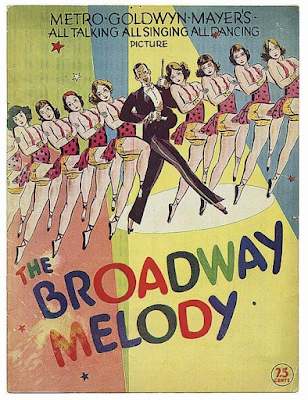






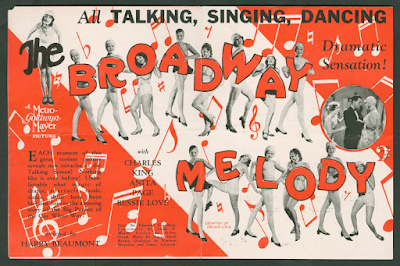









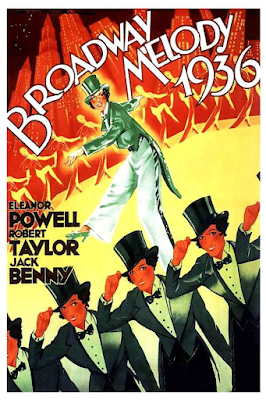










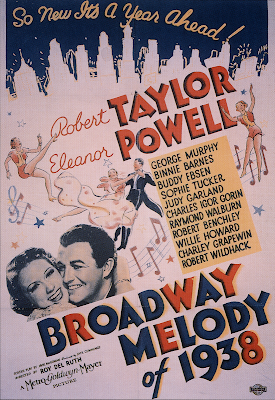






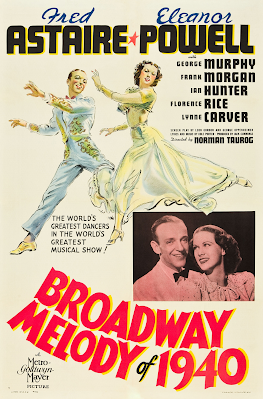


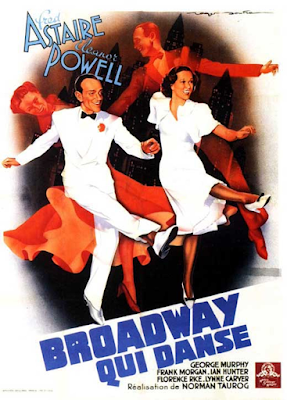





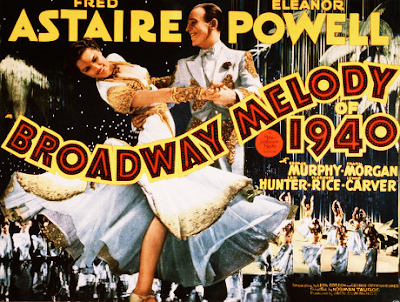



















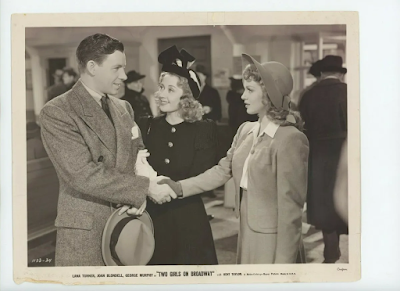






































2 comments:
Love it.
The whole Broadway think is as strong now as it was in 1939, right? I watch the award shows and they're still hungry for that fame. Being on Broadway is the dream of many a gay theater kid to this day...
XOXO
Ah, back when all-singing, all-dancing musicals on the big screen were popular. Bringing Broadway to the masses is what it was. They're still fun to watch!
Post a Comment